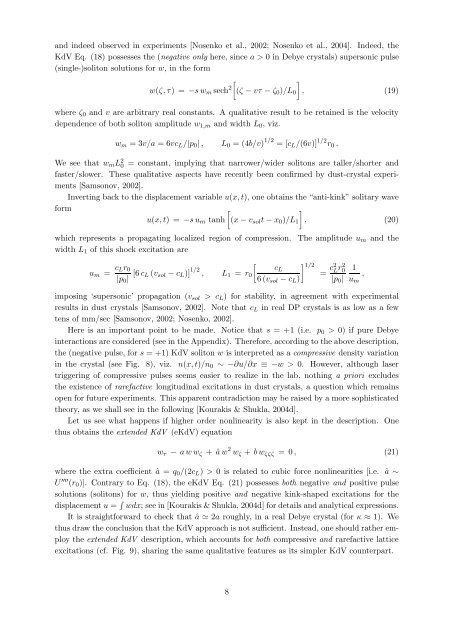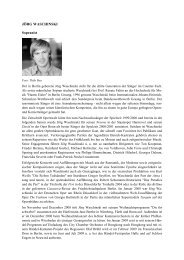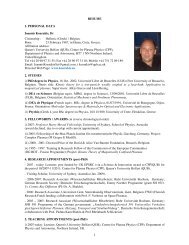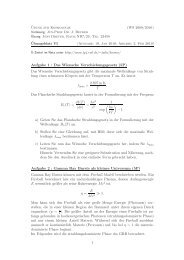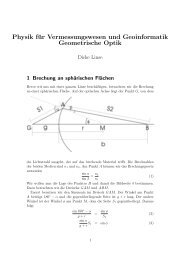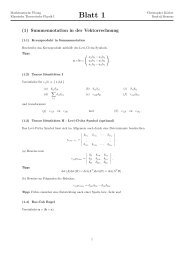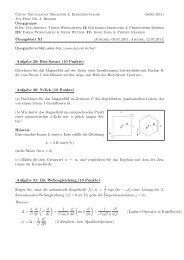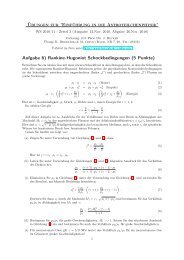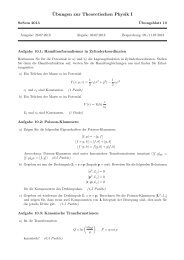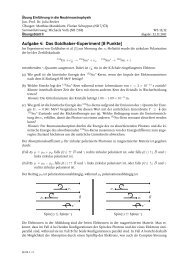View - Theoretische Physik IV - Ruhr-Universität Bochum
View - Theoretische Physik IV - Ruhr-Universität Bochum
View - Theoretische Physik IV - Ruhr-Universität Bochum
You also want an ePaper? Increase the reach of your titles
YUMPU automatically turns print PDFs into web optimized ePapers that Google loves.
and indeed observed in experiments [Nosenko et al., 2002; Nosenko et al., 2004]. Indeed, the<br />
KdV Eq. (18) possesses the (negative only here, since a > 0 in Debye crystals) supersonic pulse<br />
(single-)soliton solutions for w, in the form<br />
w(ζ,τ) = −s w m sech 2 [<br />
(ζ − vτ − ζ 0 )/L 0<br />
]<br />
, (19)<br />
where ζ 0 and v are arbitrary real constants. A qualitative result to be retained is the velocity<br />
dependence of both soliton amplitude w 1,m and width L 0 , viz.<br />
w m = 3v/a = 6vc L /|p 0 |, L 0 = (4b/v) 1/2 = [c L /(6v)] 1/2 r 0 .<br />
We see that w m L 2 0 = constant, implying that narrower/wider solitons are taller/shorter and<br />
faster/slower. These qualitative aspects have recently been confirmed by dust-crystal experiments<br />
[Samsonov, 2002].<br />
Inverting back to the displacement variable u(x,t), one obtains the “anti-kink” solitary wave<br />
form<br />
]<br />
u(x,t) = −s u m tanh<br />
[(x − v sol t − x 0 )/L 1 , (20)<br />
which represents a propagating localized region of compression. The amplitude u m and the<br />
width L 1 of this shock excitation are<br />
u m = c [<br />
Lr 0<br />
|p 0 | [6c L (v sol − c L )] 1/2 c L<br />
, L 1 = r 0<br />
6(v sol − c L )<br />
] 1/2<br />
= c2 L r2 0<br />
|p 0 |<br />
1<br />
u m<br />
,<br />
imposing ‘supersonic’ propagation (v sol > c L ) for stability, in agreement with experimental<br />
results in dust crystals [Samsonov, 2002]. Note that c L in real DP crystals is as low as a few<br />
tens of mm/sec [Samsonov, 2002; Nosenko, 2002].<br />
Here is an important point to be made. Notice that s = +1 (i.e. p 0 > 0) if pure Debye<br />
interactions are considered (see in the Appendix). Therefore, according to the above description,<br />
the (negative pulse, for s = +1) KdV soliton w is interpreted as a compressive density variation<br />
in the crystal (see Fig. 8), viz. n(x,t)/n 0 ∼ −∂u/∂x ≡ −w > 0. However, although laser<br />
triggering of compressive pulses seems easier to realize in the lab, nothing a priori excludes<br />
the existence of rarefactive longitudinal excitations in dust crystals, a question which remains<br />
open for future experiments. This apparent contradiction may be raised by a more sophisticated<br />
theory, as we shall see in the following [Kourakis & Shukla, 2004d].<br />
Let us see what happens if higher order nonlinearity is also kept in the description. One<br />
thus obtains the extended KdV (eKdV) equation<br />
w τ − aw w ζ + â w 2 w ζ + bw ζζζ = 0, (21)<br />
where the extra coefficient â = q 0 /(2c L ) > 0 is related to cubic force nonlinearities [i.e. â ∼<br />
U ′′′′ (r 0 )]. Contrary to Eq. (18), the eKdV Eq. (21) possesses both negative and positive pulse<br />
solutions (solitons) for w, thus yielding positive and negative kink-shaped excitations for the<br />
displacement u = ∫ wdx; see in [Kourakis & Shukla, 2004d] for details and analytical expressions.<br />
It is straightforward to check that â ≃ 2a roughly, in a real Debye crystal (for κ ≈ 1). We<br />
thus draw the conclusion that the KdV approach is not sufficient. Instead, one should rather employ<br />
the extended KdV description, which accounts for both compressive and rarefactive lattice<br />
excitations (cf. Fig. 9), sharing the same qualitative features as its simpler KdV counterpart.<br />
8


